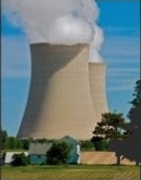Michael Phillis and Jim Salter/Associated Press
The federal government and companies responsible for nuclear bomb production and atomic waste storage sites in the St. Louis area in the mid-20th century were aware of health risks, spills, improperly stored contaminants and other problems but often ignored them, according to documents reviewed by The Associated Press.
Decades later, even with much of the cleanup complete, the aftereffects haunt the region. Federal health investigators have found an increased cancer risk for some people who, as children, played in a creek contaminated with uranium waste. A grade school closed last year amid radiation concerns. A landfill operator is spending millions to keep underground smoldering from reaching nuclear waste illegally dumped in the 1970s.
The AP examined hundreds of pages of internal memos, inspection reports and other items dating to the early 1950s, and found nonchalance and indifference to the risks of materials used in the development of nuclear weapons during and after World War II.
This story is part of an ongoing collaboration between The Missouri Independent, the nonprofit newsroom MuckRock and The Associated Press. The government documents were obtained by outside researchers through the Freedom of Information Act and shared with the news organizations.
Consider a 1966 government inspection report on a site in St. Louis County, which noted that “in a number of places along the roadway” material that later tested positive for radioactivity “appeared to have fallen from vehicles.”
A follow-up inspection three months later found the material was still sitting on the road. The company, Continental Mining and Milling Co., said it was having trouble with the contractor — a lone man who used a shovel and broom to pick up the atomic waste and put it in a pickup truck.
The company was not penalized.
The AP review didn’t uncover evidence of criminal wrongdoing. What it did find were repeated instances where companies, contractors or the government could have addressed significant problems but didn’t.
Dawn Chapman of the activist group Just Moms STL — a group pushing for cleanup and federal buyouts in an area near the airport — said the region “saved our country” with its work on the nuclear program but paid a terrible cost.
“We are a national sacrifice zone,” she said.
THE HISTORIC ROLE OF ST. LOUIS
St. Louis was part of a geographically scattered national effort to build a nuclear bomb that was tested in New Mexico. Much of the work in the St. Louis area involved uranium, where Mallinckrodt Chemical Co. was a major processor of the element into a concentrated form that could be further refined elsewhere into the material that made it into weapons.
“This is an enterprise of heavy industry,” said Gwendolyn Verhoff, a historian at St. Louis Community College.
Just months after the Japanese attacked Pearl Harbor on Dec. 7, 1941, Mallinckrodt began processing uranium near downtown. In 1946, the government bought land near the airport and began trucking nuclear waste from the Mallinckrodt facility.
Meanwhile, starting in 1941, the government began making explosives at a new plant in Weldon Spring. Production there ended in 1945, but not before soil, sediments and some springs were contaminated.
In 1957, the Atomic Energy Commission opened a plant in Weldon Spring and Mallinckrodt moved its uranium processing there. Radioactive waste contaminated the area, including a large quarry that eventually became a Superfund cleanup site in 1987. The rest of the Weldon Spring site was added two years later.
Alison Carrick, co-director of “The First Secret City,” a documentary about the region’s nuclear history, said after the war some companies thought that byproducts of the radioactive material could be sold.
But that didn’t work. So the waste moved to new sites, contaminating more land, near more people.
In 1966, the Atomic Energy Commission demolished and buried buildings at the airport site. Continental Mining and Milling Co. moved the waste to 9200 Latty Ave. in nearby Bridgeton, piling it in a heap, the commission said at the time. Radioactive barrels lay outside the fence. Storage was so haphazard that even the path to the site was contaminated by trucks that spread waste on their hauls from 1966 to 1969.
Tons of that nuclear waste flowed into Coldwater Creek, contaminating the often-flooding waterway and adjacent yards for 14 miles, state and federal investigators determined.
In 1973, the uranium processor Cotter Corp. took hazardous leached barium sulfate from Latty Avenue to the West Lake Landfill, also in Bridgeton. The material contained uranium residue.
The government cleanup of Weldon Spring is complete, but the site is considered permanently damaged and will require oversight into perpetuity. Rather than remove the waste, the government built a 75-foot-tall mound, covered in rock, to serve as a permanent disposal cell for much of the waste. The government said the site is safe, but some local residents still worry. About 5,300 people live in Weldon Spring, but tens of thousands more live within a few miles in neighboring O’Fallon.
Federal officials plan to remove some of the waste at West Lake Landfill and cap the rest. Cleanup of Coldwater Creek is far along, but isn’t expected to finish until 2038. Cleanup efforts have cost taxpayers more than $1 billion, and millions more will be needed to finish the job.
The AEC, historically responsible for the nation’s nuclear weapons program, was abolished in the 1970s, in no small part because of public criticism of its handling of nuclear safety. The Department of Energy is now responsible for overseeing the country’s nuclear weapons and waste. The department has publicly detailed the environmental damage earlier waste mismanagement caused to people and the environment. Now, the Army Corps of Engineers handles cleanup at several former nuclear program sites, including in St. Louis.
[…]
IGNORING THE ENVIRONMENT
Less than a year after victory in World War II, Winston Churchill traveled to a small Missouri town and announced a turning point in history: an “iron curtain” had descended on Europe. The brutality of global war quickly transitioned to a dangerous standoff with the Soviet Union. In America’s push for nuclear dominance, across the St. Louis region, when harmful waste was dumped, officials were indifferent to the hazards posed by materials that were so vital for the nuclear program.
The focus was on speed and secrecy. The environment was secondary.
Take a March 17, 1953, memo from Merril Eisenbud, health and safety division director for the Atomic Energy Commission, concerning a barium cake spill that left a half-mile of road, its shoulder and part of a corn field with nuclear contamination. Eisenbud wrote that in his opinion “no emergency existed.”
“A decision as to what action to take will undoubtedly involve a balance between costs, potential risks, public relations aspects,” Eisenbud said.
In a May 27, 1966, memo from a senior radiation specialist for the Atomic Energy Commission, it was noted that at Continental, an inspector found a pile of uranium material 30 feet wide, 100 feet long and nearly 8 feet high that was not in a secure area behind fencing and a locked gate, as the contract required. About 100 barrels of “miscellaneous residues” also were found outside the fenced area.
An on-site manager said he was unfamiliar with the storage requirements, the inspector wrote. When he turned to the company’s vice president in Chicago, he got nowhere.
The vice president “immediately submitted that most of what the inspector was talking about was not understood,” the memo stated. “He went on to explain that he had taken over as Executive Vice President of CMM as a protection of the money invested by a number of individuals.”
Continental was not penalized.
It wasn’t just in St. Louis. At the arid Los Alamos site in New Mexico where weapons were developed, for example, waste was thrown into nearby canyons.
Handling waste “was shielded from any greater public oversight or attention,” Edwin Lyman, director of nuclear power safety with the Union of Concerned Scientists, told AP. Environmental standards at the time were looser and the program’s secrecy allowed bad practices to continue for too long, he said.
Workers received some protection but health risks were in some cases ignored or written off.
Another 1966 report noted that Continental used the Nuclear Consultant Corp.’s field badge service to track radiation exposure among workers. The report found radiation levels so high for some workers that some at the company doubted the results.
“They did not see how people could be getting that much exposure,” it stated.
The memo showed no evidence that any action was taken.
WORKER HARM AND ADVOCACY
Efforts to force cleanup have been led largely by women who wouldn’t take no for an answer.
Denise Brock’s father worked for years at Mallinckrodt. When he had cancer when she was young, she would sometimes stay home from school to help care for him. He died in 1978.
When Brock learned in 2001 that former Mallinckrodt workers with certain types of cancer were eligible for federal compensation, her effort to help her mother get payment grew into an activist role. In 2003, she founded the United Nuclear Weapons Workers in her home, and worked with others to convince federal lawmakers to make it easier for thousands of former workers to get compensation for their illnesses.
Brock’s prodding led the government to begin offering up to $400,000 to those who worked at nuclear facilities across the country who developed certain cancers, or their survivors. Over the past two decades, the government has paid out $23 billion.
PRESENT-DAY FEAR
While nuclear workers had direct exposure, people who live near contamination sites worry about uncertainty. Many who grew up in the area weren’t told about the risks for decades.
In 2007, Chapman and Karen Nickel were so concerned about cancer and other unusual illnesses in their St. Louis County neighborhoods that they formed Just Moms STL.
In 2019, the federal Agency for Toxic Substances and Disease Registry issued a report that found people who regularly played in Coldwater Creek as children from the 1960s to the 1990s may have a slight increased risk of bone cancer, lung cancer and leukemia. The agency determined that those exposed daily to the creek starting in the 2000s, when cleanup began, could have a small increased risk of lung cancer.
Some experts are skeptical. Tim Jorgensen, a professor of radiation medicine at Georgetown University, said the biggest risk factor for cancer is age and local radiation’s contribution would be so low as to be hard to detect, he said.
“The public also tends to overestimate the risk of radiation-induced cancer,” Jorgensen said.
The government’s sloppy handling of nuclear contamination over decades has understandably made people doubt official promises that conditions are safe now, said Arjun Makhijani, a nuclear expert and president of the Institute for Energy and Environmental Research.
“There is zero trust,” he said.
People in the St. Louis area are concerned that more illnesses are caused by the contamination and some are pushing for legislation to compensate those who are sick. Others have sued those responsible for the waste.
[…]




